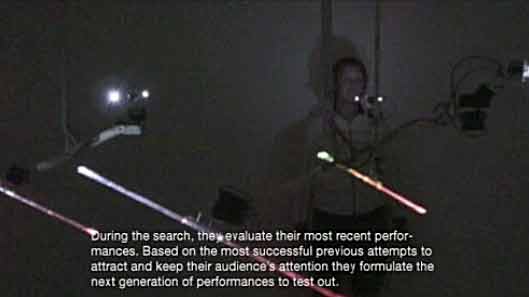Interactive Architecture: Performative Ecologies

Ruairi Glynn's Performative Ecologies project involves light, motion, and computation in an environment that watches and responds to motion in the environment. (Several video demonstrations are available at Glynn's site.)
Rather than pre-choreograph the actions of an interactive architecture, Performative Ecologies explores the role of the architect as a designer and builder of frameworks, rather than predefined events, in which responsive adaptive environments are able to not just react, but also propose. Often, through trial and error, these environments can suggest new gestural and spatial interactions and evolve their own expressive qualities while negotiating these actions with human inhabitants and other architectural systems.
Spaces and installations like this suggest what composition—writing—might become in the age of databases. Writers tending more toward design of interaction than creation of static, monolithic objects, creating a space for dynamic movement. We've had, of course, hypertext for several decades, which is a start. Dynamic features like those available in early incarnations such as HyperCard and Storyspace and later things like Flash (or any of the programmable text environments like Tinderbox, Processing, etc.) have been woefully underutilized by most writers. What will it mean when text ceases being simply an external object—at best, a pushbutton gizmo—and becomes distributed within spaces around us, responding to us?
At what point does a text cease to be like a text? When it's interactive? When it's spatial? When it's database-driven or pseudo-random? And why?
